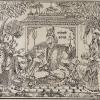BACKGROUND: Oil pulling has been used extensively for many years, without scientific evidence or proof, as a traditional Indian folk remedy to prevent teeth decay, oral malodor, bleeding gums, dryness of throat and cracked lips, and for strengthening the teeth, gums, and jaws. AIMS: The aim of this study was to evaluate the effect of oil pulling with sesame oil on the count of Streptococcus mutans in plaque and saliva of children, using the Dentocult SM Strip mutans test, and to compare its efficacy with that of chlorhexidine mouthwash. MATERIALS AND METHODS: Twenty age-matched adolescent boys were selected based on information obtained through a questionnaire. They were divided randomly into two groups: the control or chlorhexidine group (group I) and the study or oil pulling group (group II); there were ten subjects in each group. Plaque and saliva samples were collected from all the 20 subjects on the strips from the Dentocult SM kit and, after incubation, the presence of S. mutans was evaluated using the manufacturers' chart. The study group practiced oil pulling with sesame oil and the control group used chlorhexidine mouthwash for 10 min every day in the morning before brushing. Samples were collected from both groups after 24 h, 48 h, 1 week, and 2 weeks and the efficacy of oil pulling was compared with that of chlorhexidine mouthwash. RESULTS: There was a reduction in the S. mutans count in the plaque and saliva samples of both the study and the control groups. The reduction in the S. mutans count in the plaque of the study group was statistically significant after 1 and 2 weeks (P=0.01 and P=0.008, respectively); the control group showed significant reduction at all the four time points (P=0.01, P=0.04, P=0.005, and P=0.005, respectively, at 24 h, 48 h, 1 week, and 2 weeks). In the saliva samples, significant reduction in S. mutans count was seen in the control group at 48 h, 1 week, and 2 weeks (P=0.02, P=0.02, P=0.008, respectively). CONCLUSION: Oil pulling can be used as an effective preventive adjunct in maintaining and improving oral health.
 Ayurvedic medicine (also called Ayurveda) is one of the world’s oldest medical systems. It originated in India more than 3,000 years ago and remains one of the country’s traditional health care systems.
Ayurvedic medicine (also called Ayurveda) is one of the world’s oldest medical systems. It originated in India more than 3,000 years ago and remains one of the country’s traditional health care systems.